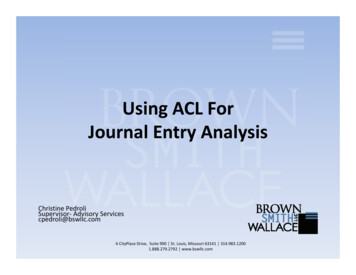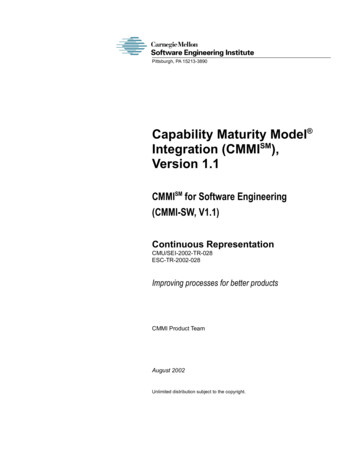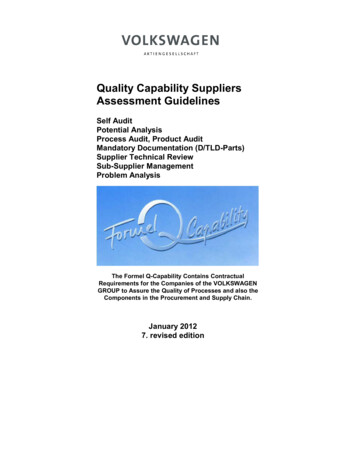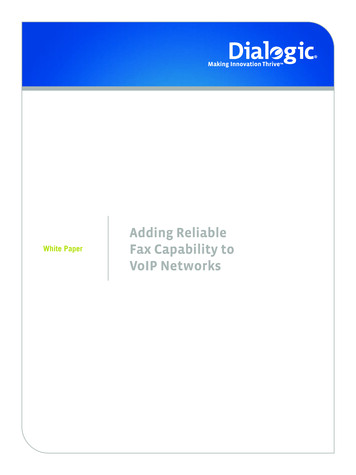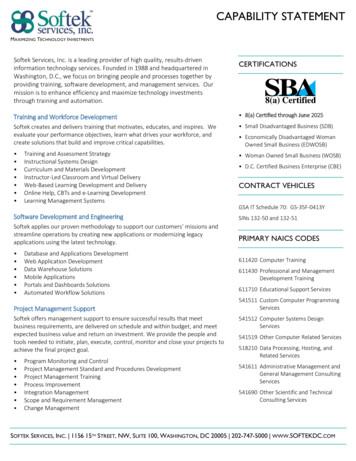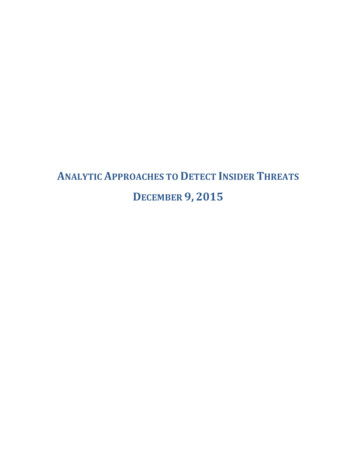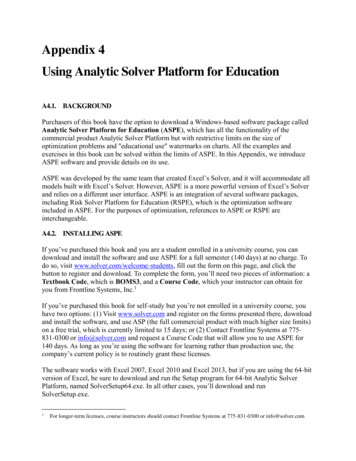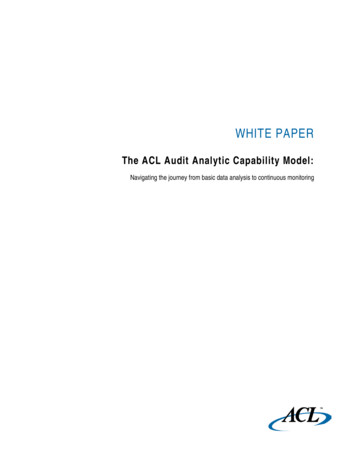
Transcription
WHITE PAPERThe ACL Audit Analytic Capability Model:Navigating the journey from basic data analysis to continuous monitoring
CO NTE NTSINTRODUCTION . 1ACL’s Audit Analytic Capability Model . 1Level 1 – Basic . 3Characteristics . 3Benefits . 3Challenges. 4Organizational Risks . 4How to Optimize . 4Level 2 – Applied . 5Characteristics . 5Benefits . 5Challenges. 6Organizational Risks . 6How to Optimize . 7Level 3 – Managed . 7Characteristics . 7Benefits . 8Challenges. 8Organizational Risks . 9How to Optimize . 9Level 4 - Automated . 10Characteristics . 10Benefits . 10Challenges. 11Organizational Risks . 11How to Optimize . 11Level 5 – Monitoring . 12Characteristics . 12Benefits . 13Organizational Risks . 14How to Optimize . 14Conclusion . 15
I NTRO DUCTI O N“The ACL Audit AnalyticCapability Model providesclear guidance fororganizations looking toimprove their use of analytics.It’s how to talk to the businessabout the value of audit.”Theodore K. Walter, CPAManager, Financial Audits at Scripps HealthToday’s business climate is driving an expansion of the role of internal audit to be more consultative andwith a stronger focus on risk management. Not only is internal audit being asked to become more efficientand effective in performing its traditional assurance role, expectations are heightened to also assess theeffectiveness of risk management processes – a challenge that is amplified by declining or, at best, flatbudgets, increasing complexities around regulatory compliance and fewer staff.The case for audit analytics has been made: In 2010, “the use of automated tools or techniques” byinternal audit functions qualified as a top-five strategic priority according to research from The Institute ofInternal Auditors (The IIA). 1 Today, a more practical focus is taking hold as organizations seek tosuccessfully implement new audit technology.For more than 20 years, ACL Services, Ltd. has worked closely with more than 14,700 customerorganizations worldwide to develop market-leading audit analytics solutions. During this time, ACL hascollected in-depth intelligence from customers who have enjoyed great benefits from using audit analytics,as well as valuable evidence from those who have not.Based on this knowledge, ACL has developed the Audit Analytic Capability Model, a framework forassessing different levels of audit analytic techniques and associated benefits. The model illustrates fiveprogressive levels through which an internal audit department should be looking to evolve its use ofanalytics, and outlines the fundamental building blocks, in terms of people, process and technology thatmust be in place to optimize benefits.ACL developed the model to help organizations more clearly evaluate their use of audit analytics and tobetter understand, plan and communicate what needs to be done to achieve and increase benefits andsuccess. This white paper will provide an introduction to the ACL Audit Analytic Capability Model and helporganizations build a roadmap for increasing analytics testing throughout their internal audit function.A CL ’S A UDI T A NAL Y TI C CA P A B IL I TY MO DE LThe traditional approach to audit has always been to take a historic or retrospective view of what hashappened over a period of time. While this approach delivers necessary and proven hindsight for auditplanning, today’s environment demands a more proactive and comprehensive view for effective riskmanagement and business assurance.Richard Chambers, president of The Institute of Internal Auditors (The IIA) reaffirmed this point during hiskeynote presentation at the 2010 General Audit Management (GAM) conference. Mr. Chambers said thatin order to increase its relevance and value, as well as secure a “seat at the table” with executivemanagement, audit needs to understand what happened yesterday, provide insight into what is happeningin the business today, and understand where the organizational risks may occur tomorrow. In short, audit1Internal Auditing in 2010: Shifting Priorities for a Changing Environment, The Institute of Internal Auditors 2011 ACL Services Ltd.ACL and the ACL logo are trademarks or registered trademarks of ACL Services Ltd. All other trademarks are the property of their respective owners.1
“This enables internal auditto shift from a reactive to aproactive approach foridentifying and managingrisk, and delivers hindsight,insight and foresight forgreater assurance and valueto the business.”needs to provide a continuum of hindsight, insight and foresight. Together, these form an internal auditdepartment’s “line of sight.”The ACL Audit Analytic Capability Model is an evolution of the continuum concept and illustrates five levelsthrough which internal audit can expand the use of data analytics to increase benefits: Basic, Applied,Managed, Automated and Monitoring.For most organizations, the sophistication of analysis capabilities correlates with the level of strategic valueand contribution that internal audit can deliver to the business. As internal audit extends the use ofanalytics and process controls are established, it advances toward an automated and continuous model.This enables internal audit to shift from a reactive to a proactive approach for identifying and managingrisk, and delivers hindsight, insight and foresight for greater assurance and value to the business. (SeeFigure 1.)Figure 1: ACL’s Audit Analytic Capability ModelData analysis by auditors plays an important role at each stage of the continuum. For example, analyticscan be used to support specific audits and to test 100% of transactions from a fiscal year or previousquarter. This enables internal auditors to identify where control failures have occurred in the past,delivering essential hindsight for compliance, governance and risk management.As audit expands the use of analytics as a centrally managed tool that is integrated into audit processes,data analysis provides more timely insight into risks and controls at a level that is simply not possiblewithout technology. Testing procedures can be repeated to enable timely analysis of large data sets and toidentify detailed instances of risk, fraud, error and abuse across multiple business process areas. 2011 ACL Services Ltd.ACL and the ACL logo are trademarks or registered trademarks of ACL Services Ltd. All other trademarks are the property of their respective owners.2
As organizations apply greater automation and continuous auditing and monitoring, audit analytics providethe ability to detect patterns or trends in audit and control issues that provide foresight on increasing orchanging risks within business and financial control processes. For example, controls monitoring routinescan be run on a daily basis. Regular analytic tests can reveal instances of specific transactions that are athreat, as well as opportunities for improving controls.Improving internal audit’s line of sight is enabled by a progression towards continuous auditing andmonitoring. Many organizations understand the benefits of automated continuous auditing and monitoringand want to move there immediately. However, without the building blocks of the lower levels in place, interms of people, process and technology, it is more difficult to achieve the intended benefits.ACL’s Audit Analytics Capability Model is intended to help organizations evaluate their use of analytics asthey progress through the levels.In the next section, we will explore the characteristics and benefits of each level. Additionally, we will lookat some of the challenges that internal auditors face while using audit analytic technology, as well as therisks that organizations may face at each level. We will also provide tips on how to optimize people,processes and technology to reduce those risks and improve the effectiveness of audit analytics asorganizations expand their use from data analysis toward continuous monitoring.L E V EL 1 – BA S I COrganizations performing at the Basic level use audit-specific data analysis technology to perform queriesand analysis of large data sets; most often for specific audits. In this scenario, an auditor typically starts byusing analytics to produce statistical overviews and classifications or summarizations of data. This allowsthe auditor to identify anomalies and to better understand the transactions and balances within a specificarea. Obvious problems such as duplicates are easily identified with pre-built analytic tests. Transactionsand master data can be compared between systems, providing indicators of errors and fraud.CharacteristicsAt the Basic level, the use of data analytics is typically ad hoc and undertaken by auditors who havereceived introductory training. There is usually little involvement from management. Often an auditor withtechnical interests selects the analytic software, which is then used by that individual or only a limitednumber of specialists within the broader audit team. As a result, the individual or a small team of dataanalysts often become skillful power users who are highly productive in terms of output.BenefitsWith initial use of audit analytic software, auditors rapidly gain a better view of risk and control issues withina given audit area. Analysis is more in-depth than can typically be obtained by general-purpose software orby manual procedures alone. For example, audit analytics allow for the review of 100% of transactions orbalances and the use of pre-built queries designed for audit purposes. 2011 ACL Services Ltd.ACL and the ACL logo are trademarks or registered trademarks of ACL Services Ltd. All other trademarks are the property of their respective owners.3
“With automated dataanalysis and daily auditreports, ACL technology hasstrengthened our internalcontrols and providedinvaluable corporateoversight.”Paul O’Sullivan, Internal AuditorFintrax GroupAs a result, auditors can quickly identify specific instances of fraud, error, and abuse, as well asinefficiencies and control weaknesses. In some cases, the time to analyze
ACL’s Audit Analytics Capability Model is intended to help organizations evaluate their use of analytics as they progress through the levels. In the next section, we will explore the characteristics and benefits of each level. Additionally, we will look at some of the challenges that internal auditors face while using audit analytic technology, as well as the risks that organizations may .
